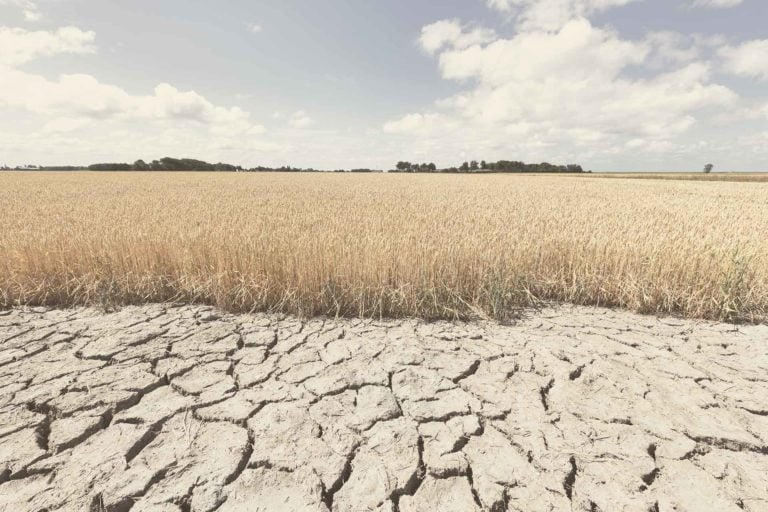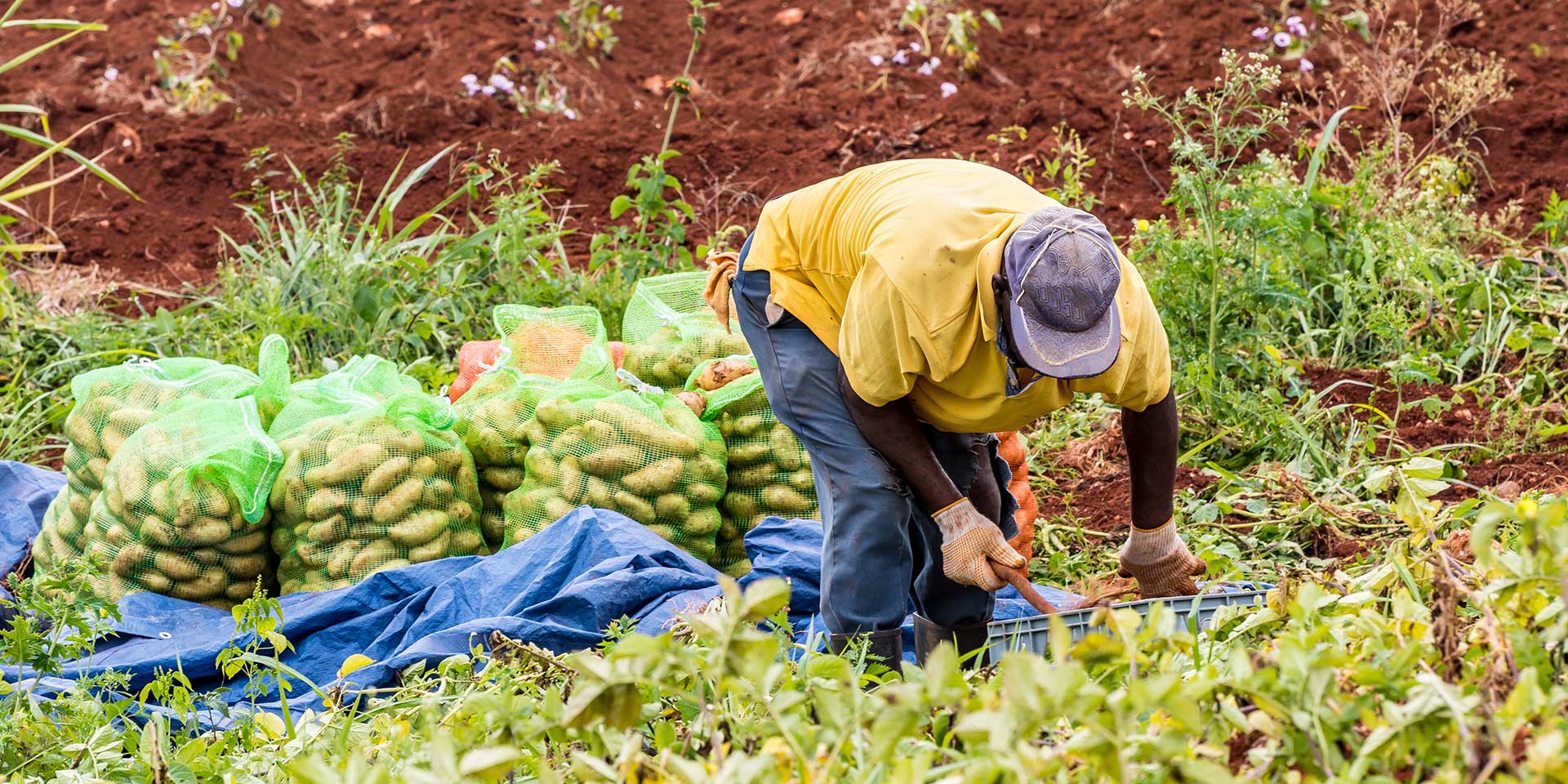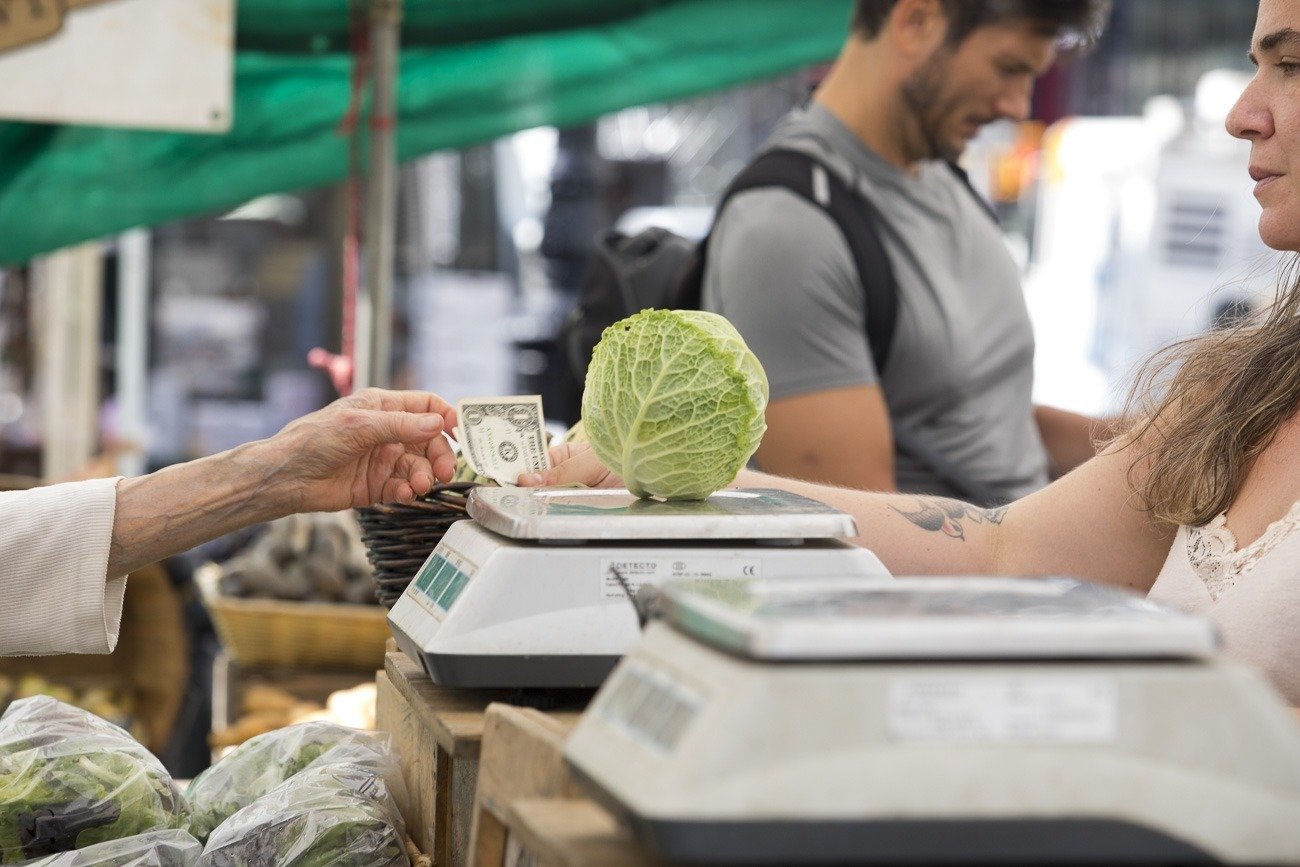Looking Back and Looking Ahead: Top Food and Agriculture Stories for 2022
Each year at FoodPrint we attempt to make some predictions about the biggest food and agriculture stories for the coming year. Usually, the best way to understand where we are going is to look at where we’ve been. But if this year showed us anything, it’s that unpredictability is the only given going forward. With an ongoing pandemic, a bumpy economic recovery and ever-escalating climate change, an increasingly volatile future is all but certain for a food system that isn’t nearly as resilient as it should be.
But amid the chaos, we found stories of people working hard to fix the problems around them. Attempts to reduce plastic waste, a resurgent food labor movement and more showed us that adapting to a more difficult world isn’t just necessary, it’s possible, and that we can build a fairer and cleaner food system in the process. As we look toward the future, we see many problems on the horizon, but continue to believe that solutions and transformative change are possible.
Climate Change Will Force Businesses and Government Towards a Reckoning
Climate change and its impacts on the food system once again took center stage in 2021. Extreme heat, droughts and a severe wildfire season in the west, especially in California, made many crops ungrowable and forced ranchers to cull cattle they couldn’t feed, with Indigenous farmers who are cut off from water access hit the hardest. Extreme weather events in the rest of the country caused serious damage to crops in the growing season and accelerated erosion that further stripped nearly depleted soils.
All of this forced a reckoning about how and where we produce our food. As regions like California’s Central Valley become drier, we must ask ourselves: are they still a good place to produce the majority of our fresh produce? Is it worthwhile to grow low-value, thirsty crops like alfalfa in the desert just to supply mega-dairies? Can we continue to devote so much land to industrial corn and soy as production becomes unreliable? How can we keep workers safe from dangers like extreme heat and wildfire smoke?
Climate change is becoming impossible to ignore, and big companies and government officials have realized they must acknowledge the problem. But while big companies talk about going carbon neutral and adopting regenerative agriculture, they’re not always committed to effective solutions. After a lackluster UN climate conference barely mentioned agriculture and a sustainable agriculture summit where industry representatives complained that the real problem is the uneducated, meat-phobic public, it doesn’t seem like big corporations are willing to make the changes necessary to dramatically cut emissions. Those responsible for regulating them, like the head of the Department of Agriculture (USDA), who recently insisted Americans don’t need to reduce their meat intake to slow climate change, are refusing to do anything to make cleaner production mandatory. Instead, we’re likely to see even more motions towards voluntary measures that mainly benefit large farmers and agribusinesses.
In the coming year, the conversation around carbon markets, which pay farmers for storing carbon in the soil, is only going to get bigger, in spite of serious concerns about what happens to that carbon when soil gets plowed over later and more fundamental questions of how much carbon soil can hold in the first place. One thing is certain: we will continue to face the effects of climate change and our food system will suffer as a result. As things get worse, both business and government might have no choice but to make bigger changes and stop fiddling around the edges with minor or partial solutions.
Workers Will Continue To Build Power
The pandemic brought new risks to workers, and outbreaks throughout the food system — especially in meatpacking plants, where more than 59,000 workers have gotten sick so far — helped remind the broader public exactly how difficult most jobs in the food system really are. While vaccines helped alleviate some of the risk associated with COVID-19 this year, outbreaks continued, particularly among populations like undocumented farm and processing plant workers who were hesistant or unable to access medical care for fear of deportation. Meanwhile, many companies acted like the pandemic was over, withdrawing benefits like sick leave that workers had fought so hard to win.
But this year’s economic recovery also shifted the balance of power between workers and employers. Aided by generous unemployment benefits and a wide-open job market, workers were empowered to ask for what they deserved. The year started with a strike at Hunt’s Point in New York, one of the country’s largest produce distribution hubs. Workers there were successful in securing a much-needed raise. The summer saw strikes at Nabisco and Frito-Lay, where employees negotiated guaranteed time off. By the fall, strikes became so commonplace that labor analysts dubbed the month of October “Striketober.” Even now, an ongoing strike at Kellogg — and a statement of support from the White House — shows food system workers are still feeling empowered.
Even when they weren’t striking, workers still made big gains across the food system. The fight for a fair minimum wage picked up steam, with many companies announcing raises to attract or retain employees. Unionization efforts moved ahead at many workplaces, including longtime anti-union bastions like Starbucks and fast food chains. Farm workers on temporary visas also secured a raise thanks to a lawsuit that forced an update in Labor Bureau policies, affecting thousands nationwide.
Going forward, we’re optimistic that workers in the food system will hold a better hand than before. It’s unlikely that today’s job market will favor employees forever, but gains like unionization mean that workers will have a better bargaining chip than before as conditions change. Government support will also play a role in improving conditions for workers, and the new administration’s efforts to expand regulatory protections for workers (like Occupational Safety and Health Administration (OSHA)’s directive to finally develop guidelines for working in extreme heat) will help guarantee a safer food system going forward. Meanwhile, propositions from legislators, like Senator Cory Booker’s Protect America’s Meatpacking Workers Act, could help keep some of the most at-risk workers safe from accidents and other dangers.
Debt Relief May Come for Black Farmers, but Possibly Not Soon Enough
From slavery through today, the agricultural history of the US has been tied to exploitation of Black people. Even after they were allowed to own land, Black farmers have never gotten a fair deal: discrimination from the USDA and other agencies means that Black farmers have never had the same access to low-interest loans, subsidy payments and other supports enjoyed by white farmers. After so many decades of official discrimination, Black farmers make up less than 2 percent of all farmers today, down from 14 percent in 1920. With that in mind, Congress allocated $4 billion to a debt relief program specifically for farmers of color, which civil rights watchdogs said was a pivotal first step towards reversing the USDA’s long legacy of structural racism.
But the move generated political outcry. Banks, which depend on high interest rates paid over long periods, said the move would cut into their profits. Right wing political operatives, capitalizing on widespread misunderstanding of critical race theory, worked with wealthy white farmers to argue in several lawsuits that the program was racially discriminatory against white farmers, freezing the program before it ever went into effect.
While finances have never been easy for farmers of color, this debt relief was particularly important for smaller farms trying to emerge from the pandemic downturn. Every day without aid means more Black-owned farms at risk of going under. This year, as the USDA fights in court to get the program running, lawmakers may have found a workaround: creating a similar program aimed at economically stressed farmers with no mention of race. That program might be easier to defend from discrimination claims, but stil provides relief to many of the same farmers. However, as the provision is tied to the Build Back Better Act — currently stalled in the Senate — debt relief may not come soon enough for many Black farmers.
The Future of Supply Chain Disruptions and Inflation Remain Unpredictable
Many industries are still grappling with the rippling effects of the pandemic, and those disruptions haven’t spared the food system either. Nearly everything about food production has become more expensive, from high fuel costs driving sky-high fertilizer prices to shortages of truck drivers and shipping containers pushing shipping costs up. Globally, this means food prices are the highest they’ve been since 2011.
While the expansion of the country’s food safety net kept overall hunger rates stable, many people are still feeling the pinch. Meanwhile, politicians around the country have proposed eliminating grocery taxes to provide families with some relief.
Can we expect these high food prices to stick around in 2022? It’s hard to say. Prices on corn, soy and wheat have already fallen from their high point earlier this year, and slight declines in fuel costs are also a sign that food prices might fall slightly in the future. Experts agree they aren’t likely to drop quickly, however.
Ultimately, the food price crisis points to the same problem we’ve been seeing throughout the pandemic: our industrial food system, widely touted as efficient, isn’t as resilient to shocks as it should be. In particular, our overreliance on fossil fuels and everything that comes from them — like synthetic fertilizers — is a liability as we look at a future where instability is a given.
The Government Will Try to Rein in the Meat Industry
Food prices rose overall this year, but meat in particular has gotten more expensive. While this is partially due to higher prices for corn and soy internationally, it may also be the result of more intentional manipulation by meatpackers. Investigations into industry antitrust violations have happened in previous administrations, but, so far, the Biden Administration has taken a more aggressive line, releasing their own analyses this year that suggested more than half of the increase in grocery prices since last year was due to profit-maximizing behavior from the industry.
This is a very different story from the one the meat industry has told consumers — that rising prices are the result of farming inputs growing more expensive. But it parallels what farmers and ranchers have been seeing for years: meat companies also aren’t adequately compensating farmers for the full costs of their products.
With one completed investigation into price-fixing in poultry leading to an ongoing criminal trial for executives, The Department of Justice is already delivering more consequences than the industry is used to. In 2022, this will continue as the administration, eager to pin high grocery prices on the meat industry rather than inflation, continues to investigate.
This also extends to support for small and midsize processors, which started this year when the federal government pledged $500 million in grants to support new independent meat processors, vital support for building the capacity of regional food systems that can offer both farmers and consumers fairer prices than the big meat conglomerates do.
Technology Alone Won’t Fix the Food System
One of last year’s big stories was the explosion of plant-based analogs to animal products. Spurred in part by pandemic disruptions to meat supply chains, and growing concerns about meat’s impacts on climate change, many people experimented with newly available fake meats. The sector’s sales grew 27 percent in 2020, leading many (including us in our predictions last December) to say that the sector’s meteoric rise would continue this year. The plant-based industry’s offerings continue to expand, with announcements of Impossible Pork and even seafood grown from fungal mycelium.
But the plant-based sector didn’t see the same explosion of growth in 2021 that it did in 2020. First, disappointing sales figures from Beyond Meat and the rest of the plant-based sector (falling 1.8 percent from last October to this one) cast doubt on the optimistic projections that plant-based meat would quickly displace the real thing. Production hurdles around new products and personnel shakeups at several companies compounded that uncertainty. Meanwhile, journalists brought us stories that showed that some innovations — particularly cheap lab-grown meat — are probably at least a decade away from commercial viability.
These revelations helped to bring a much-needed discussion about tempering expectations that technology alone can change the food system. Going forward, we should still expect innovation to be a part of the conversation about food and sustainability. New foods and new production methods still have the potential to help a lot of people change their diets. But we should also recognize that new tech isn’t a silver bullet because it doesn’t address the food system’s primary problems, namely the economic and government incentives that drive industrial agriculture to overproduce commodities like corn and soy in the first place. Given that Congress needs to pass a new Farm Bill (the legislation that determines most of the county’s agricultural policy) by 2023, next year will be a time that environmental advocates, industry representatives, and legislators renegotiate all of those priorities.
The Fight for Better Food Packaging Will Pick Up Steam
As we predicted late last year, the fight against single-use food products and packaging has resumed. Once scientists learned enough about COVID-19 to determine that surface transmission was not a threat, plastic bag bans were reinstated, coffee shops started to accept reusable cups again and reusable container programs — for grocery store foods, milk bottles and even fast food burger clamshells — ramped up. The understanding at this point is that consumers want these programs and are interested in cutting back on their packaging waste. Many companies recognize this and are hunting for solutions.
Realistically, the best hope right now is to slow the steady growth of the plastics industry. In July the Plastics Association reported that plastic production is on track to increase by 9 percent this year, and statistics show that we are only recycling a fraction of it. Legislation that regulates plastic does make a difference, as does legal movement in the banning of “forever chemicals” officially called PFAS, which won’t make food packaging less ubiquitous but will make it safer.The trick going forward is to take the onus off of consumers, to make using less packaging (or better packaging) something that anyone can do with reasonably little effort.
People Will Notice Where Their Food Comes From
The supply chain disruptions of the past year and a half have meant that more and more people understand that food doesn’t just appear in the grocery store or at restaurants. Whether it was encountering empty shelves or reading about tragic outbreaks at meatpacking plants, the average consumer understands more clearly now that there’s a process — logistics and labor and transportation — that determines if and when we will get fed, and what kind of sacrifices it takes to bring food to our tables.
Consumer research seems to indicate that a growing number of people also care about the how: the post-pandemic consumer is apparently “more conscious of the sustainability of their consumption.” People are looking for foods that are “climate-friendly” — whether that’s “plant-based” burgers or food with carbon footprint labels, even as food prices climb. But consumers aren’t stupid, and while there will be no shortage of companies that try to cash in on climate-friendly eating as a trend — like the recent announcement of “climate friendly chicken” that doesn’t seem to go as far as existing certifications like USDA organic — we’re encouraged by some developing certifications that might bring much-needed transparency to the supply chains of companies that want to distinguish themselves by actually following through on their climate commitments.
Get the latest food news, from FoodPrint.
By subscribing to communications from FoodPrint, you are agreeing to receive emails from us. We promise not to email you too often or sell your information.
Top photo by irissca/Adobe Stock.
More Reading
Can rye growers get consumers and retailers excited about rye?
May 19, 2025
Can private grants fill regenerative agriculture's federal funding gap?
May 1, 2025
Books to inspire young environmentalists
April 22, 2025
Our latest podcast episode on pistachios: The making of a food trend
April 1, 2025
How refrigeration transformed our palates and our supply chain
January 28, 2025
What to expect in food & farm news in 2025
December 24, 2024
Can sail freight tackle the large carbon footprint of food transport?
December 17, 2024
Are plastic bag bans working?
November 11, 2024
Julie Guthman explains why Silicon Valley will not hack the future of food
November 4, 2024
Greenhouse gases in the food system, explained
October 11, 2024



